The James Webb Space Telescope (JWST) has taken extreme cryogenic vacuum testing, 30 years and almost 10 billion dollars to produce. It is being called one of the major scientific ventures of the 21st Century.
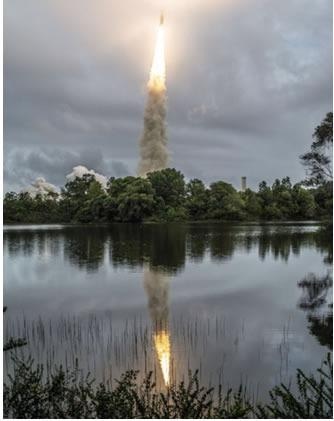
James Webb Space Telescope Launch: Image credit: NASA/Chris Gunn
On Christmas day in 2021, after more than two decades of development, the James Web Space Telescope (JWST) was launched by NASA from French Guiana on the northeast coast of South America.
The launch location was near the Equator to provide the additional push required to reach the observing spot of JWST in the anti-sunward direction.
The Sun-Earth Lagrange point 2 (L2) is almost 1 million miles (1.6 million km) from Earth, straight behind the planet. An object placed at L2 will move around the Sun with the Earth without falling behind.
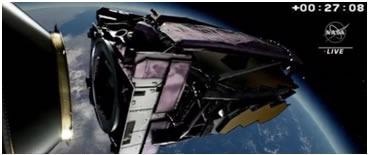
JWST Separation. Image credit: NASA/Twitter.
Twenty-seven minutes after liftoff, the second stage of the Ariane 5 rocket separated from JWST. Quickly afterward, at T+30 minutes after launch, JWST reported that the spacecraft is “power positive” and utilized its solar panels.
As it is too big to fit in any existing rocket in its complete form, the James Webb Space Telescope had to fly into space folded up.
While the Ariane 5 rocket that brought it into space is almost 18 feet, or 5.4 meters, wide, it was still not large enough to transfer JWST to space fully unfolded. It was condensed in an origami-style to fit within the rocket.
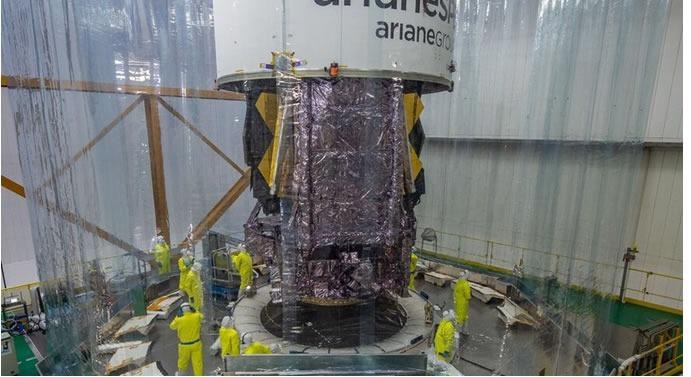
NASA's James Webb Space Telescope being encapsulated within the Ariane 5 payload. Image Credit: ESA/CNES/Arianespace
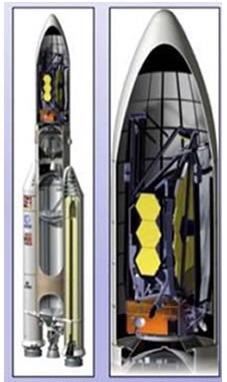
JWST inside Ariane 5 rocket (rendering). Image credit: ARIANESPACE - ESA - NASA.
JWST had to unfold its 18 gold-plated beryllium mirror segments employing 132 actuators during the trip to L2, which lasted 29 days. It used its five-layer origami sunshield and cooled down to less than 50 K (kelvin) (-223 °C or -370 °F).
The cold side will be around -394 °F (-236.6 °C or 36 K) while the sun-facing side will be at around 230 °F (110 °C). The sensitive telescope instruments are protected from sunlight interference by the five-layer sunshield. The telescope functions at less than 50 K (~-370 °F).
This length of time was called the “30 days of terror,” where there were 344 possible single-point failures in the spacecraft, 80% of which were related to deployment instruments.
For example, the sunshield contains 70 hinge assemblies, 140 release mechanisms, eight deployment motors and approximately 90 cables and 400 pulleys that are a sum of 400 meters in length.
It was challenging to put total redundancy in a release mechanism. Several deployment tests had been completed over many years on both full-sized and small models. There were a range of contingency plans in place to try to overcome any challenge if something did not function in the process of deployment.
The sunshields unfurled to reduce the heat of the telescope in the first week of the journey to L2. The aft radiator was deployed during the second week, and both the primary mirror wings and the secondary mirror support structure were unfurled.
The next stage was to align the 18 separate mirrors that constitute the primary mirror of the observatory. It is a multi-stage, multi-day activity to move and activate each of its 18 primary mirror segments (which are adjustable) once out of their launch configuration.
Six actuators move the primary mirror segments, which are fixed to the back of each piece of mirror, with a seventh actuator positioned at its center that modifies the curvature of the mirror segment.
The main mirror is the main light collection surface of the JWST. Light is reflected by this surface to the tertiary mirror positioned in front of the telescope on booms, which then reflects the light into JWST’s instruments.
All of the 18 primary mirror segments are plated in an ultra-thin, shiny layer of gold.
These would function as separate telescopes with images that would be unclear and fuzzy if left in launch position. The mirror segments, once aligned, will function as one huge mirror, the largest ever in space at 21.3 feet (6.5 meters) across.
Infant galaxies as far back as an estimated 400 million years after the big bang have been observed by the Hubble Space Telescope.
JWST will have the ability to observe much farther into the past, up to 100 million years after the big bang, a time when most matter was just beginning to form into galaxies and stars and comprised of only the primordial elements.
Some of the most distant objects in the universe will be observed by JWST. Due to this, in its over 13-billion-mile journey, the light of objects become predominantly shifted toward the red side of the electromagnetic spectrum.
The primary mirrors of JWST are plated in 24-karat gold as gold reflects red light more effectively compared to almost any other metal. The gold enables the mirrors of JWST to be 98% reflective in comparison to the usual 85% reflectiveness of common mirrors.
The gold layers plating the mirrors of the telescope are just 1,000 atoms thick. The complete 21-foot-wide mirror was coated using only a golf ball-sized amount of gold.
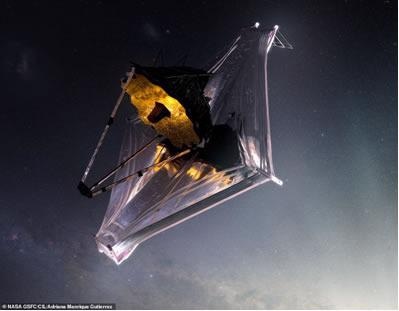
JWST in Space rendering Image Credit: NASA GSFC/CIL/Adriana Manique Guiterrez
The primary operating temperature of the telescope is just 50 degrees higher than absolute zero (-459 ºF). The lower the temperature, the less that atoms move.
At the coldest possible temperature (-459 ºF), absolute zero 0 degrees Kelvin, atoms stop moving altogether. The high-tech instruments in JWST will function at close to absolute zero to accurately monitor the data.
The telescope will not function until it has cooled down to its stable and low temperature. Five months after this, the telescope will be calibrated and tested for its science mission, scheduled in the middle of 2022.
Minus K’s Involvement in the Unprecedented Testing of JWST Before Getting into Space
Chamber-A in the NASA Johnson Space Center (JSC) was the location of all the JWST systems-level cryogenic vacuum tests.
Chamber A has become the biggest cryogenic-optical, high-vacuum test chamber globally and was renowned for testing the space capsules for NASA’s Apollo mission, with and without the mission team.
It is 90 feet (27.4 meters) tall by 55 feet (16.8 meters) in diameter. The door weighs 40 tons and is closed and opened hydraulically. The chamber air weighs 25 tons, and the mass left inside is the equivalent of half a staple when all the air is removed.
NASA JSC engineers, over a three-year period, remodeled and built the interior of the chamber for the temperature required to test the James Webb Space Telescope.
Chamber A was updated with the helium shroud, inboard of the current liquid-nitrogen shroud, which has the ability to drop the temperature of the chamber farther down than ever, which is 11 degrees more than absolute zero (11 kelvin, -439.9 ºF or -262.1 ºC).
A major addition to Chamber A was the inclusion of a set of six custom 10,000 lb. capacity Minus K Technology’s negative-stiffness vibration isolators.
Electricity and air are not required by Minus K’s passive isolators, and they provide superior isolation compared to active and air isolation systems.
The main consideration in the choice of vibration isolators was that they isolate vibration horizontally at less than 1 Hz along with isolating vibration vertically.
JWST was engineered to function in space where the interferences only come from the spacecraft and are highly controlled. On Earth, all the ground-based interferences, such as motors, pumps and even traffic driving by, can impact the testing.
The Minus K vibration isolators supplied dynamic isolation from external sources of vibration to produce an almost disturbance free flight-like environment.
The isolators feature Minus K’s patented Thermal Responsive Element (TRE) compensator device, a passive mechanical device that requires no electricity or air, similar to the isolators.
As the temperature changed during the testing at JSC, the TRE compensator adjusted the isolators to continually provide the best isolation for the testing.
The Critical Design Review for Spacecraft-to-Optical Telescope Element vibration isolation system was finished one month earlier than predicted, at the end of 2011.
As shown in the image below, in March 2014, the six Minus K negative-stiffness vibration isolators were fixed on top of the Thermal Vacuum Chamber A at the Johnson Space Center.
JWST required a support structure within the vacuum chamber to hold equipment for the testing.
A huge steel platform was installed by the engineers. It was suspended from the six vibration isolators using steel rods about 1.5 inches (or 28.1 mm) in diameter and around 60 feet long (18.2 meters), to hold the telescope and important parts of test equipment.
The advanced optical telescope test equipment consisted of auto-collimating flat mirrors, an interferometer and a system of photogrammetry ‘precision surveying’ cameras in exact relative alignment within the chamber.
The engineers could therefore monitor the JWST while it was under testing.
These were isolated from any vibration sources, for example, the flow of helium and nitrogen within the shroud plumbing and the rhythmic pulsing of vacuum pumps.
Further test support equipment included television cameras, mass spectrometers and infrared cameras, which were also fixed to the support structure that was suspended in isolation from vibrations using the Minus K negative-stiffness isolators.
JWST Pathfinder tests were scheduled into the three main test campaigns before the last cryogenic vacuum test of the Integrated Science Instrument Module (ISIM) and the fully assembled flight Optical Telescope Elements (OTE).
The three Pathfinder tests are OGSE1, OGSE2, and the ‘Thermal-Pathfinder’ (TPF).

Pathfinder tests stages OGSE1, OGSE2, 'Thermal-Pathfinder' (TPF) and the fully assembled flight Optical Telescope Elements (OTE) and the integrated Science Instrument Module (ISIM) called (OTIS). Image Credit: NASA
These tests were enhanced to be more thorough to fully characterize the test facility, such as the Ground Support Equipment (GSE) and the cryogenic test chamber. In the Pathfinder tests, the ‘flight like’ test articles were devised to establish the thermal behaviors inside of the cryogenic environment.
The 30-day OGSE1 test was finished in May 2015 after the JSC Chamber-A was effectively commissioned in 2014 for JWST use.
The OGSE2 cryo-vacuum test, lasting 35 days, was finished in October 2015, where all primary, secondary and tertiary test objectives were achieved.
A major milestone for JWST was achieved upon the successful completion of the OGSE2. This test was the first important cryogenic test with specialized fiber-fed optical equipment and the actual flight telescope optical elements.
It was the first test with the Aft-Optics-Subsystem (AOS) Source Plate Assembly or ASPA, created to reveal the optics of the telescope via the focal planes.
The flight Fine Steering Mirror (FSM) and Tertiary Mirror (TM), contained in a bundle known as the Aft-Optics-Subsystem, was optically tested in its operational cryogenic environment in an integrated configuration.
In June 2015, before the ‘Thermal-Pathfinder’ (TPF) test and after the OGSE1 and OGSE2 tests, L3Harris (formerly ITT Exelis), who installed and commissioned the six negative-stiffness vibration isolators on top of Chamber A, made modifications with the help of Minus K to the chamber isolators, aligning them to their designed natural frequency of 0.5 Hz.
This enabled the isolators to offer an enhancement in the reduction of vibrations on the two primary mirror segments of TPF test.
The Thermal Pathfinder (TPF) cryogenic test, lasting 35 days, was finished in October 2016. The TPF involved two spare flight-rated beryllium mirrors (one gold-coated) and ten non-flight gold-coated aluminum test segments operating as thermal simulators.
The mirrors had to be aligned or “phased” to a distance less than the wavelength of light during the optical tests. This is thousands of times less than the thickness of a human hair at a temperature hundreds of degrees below zero.
Thermal Pathfinder underwent all vacuum and thermal tests that the actual JWST was scheduled to go through in 2017.
In July 2017, the fully assembled JWST Optical Telescope Elements and Integrated Science Instrument Module (OTIS) underwent the final 93-day test.
The air from the chamber was pulled in around ten days, and then another month was needed to reduce the temperatures of JWST and its scientific equipment to the levels necessary for testing.
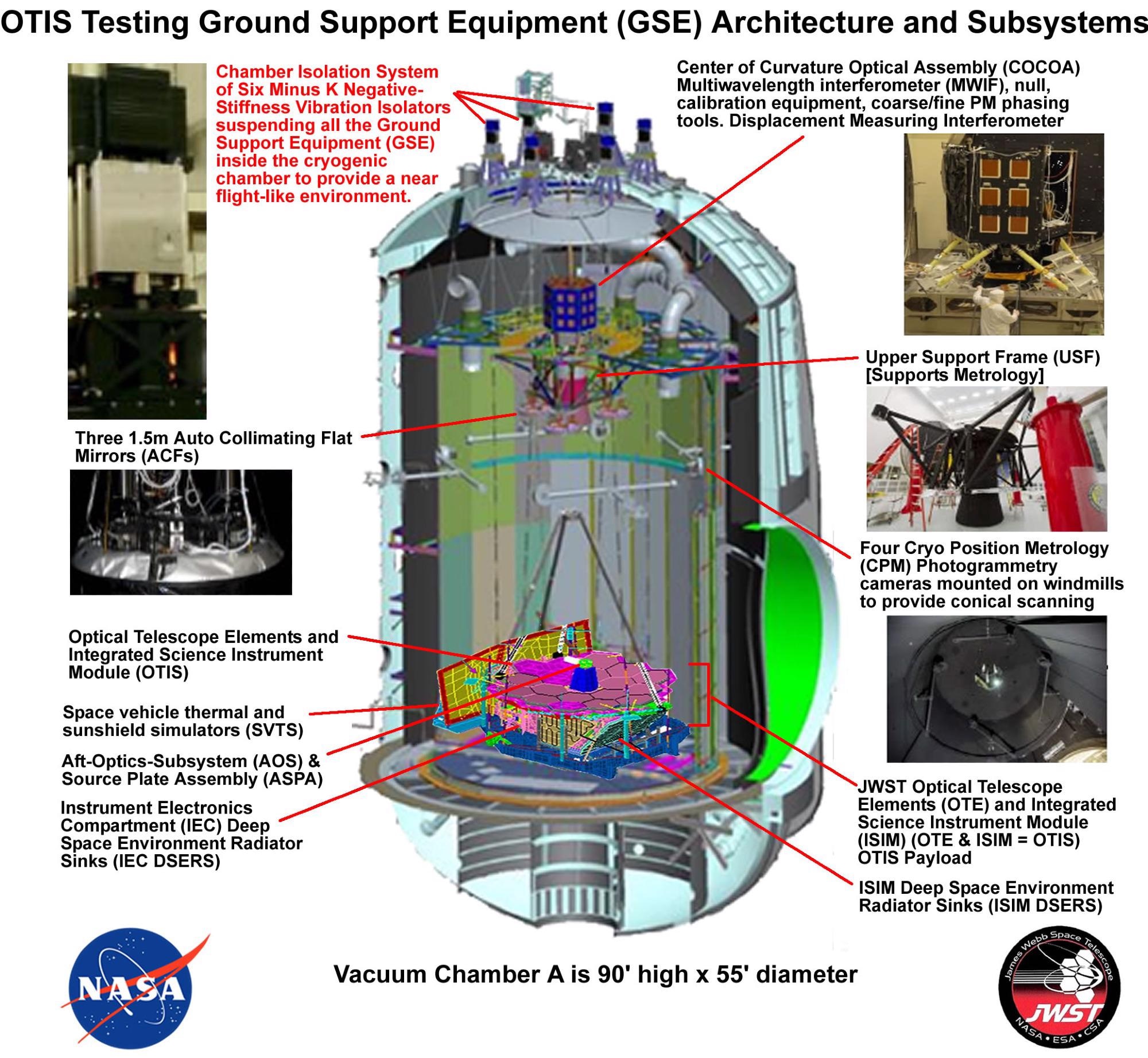
Image Credit: Minus K Technology
These tests involved a crucial alignment evaluation of JWST’s 18 primary mirror segments to ensure that all hexagonal, gold-plated segments functioned as a single, monolithic mirror.
All 132 hexapod actuators had to be tested for radius of curvature for each mirror segment and 6 degrees of freedom (DOF). This was the first time the optics of the telescope and its instruments were tested simultaneously.
It was a complex and lengthy testing procedure to test the JWST. The environments it will encounter inside the cold vacuum of space were replicated on the ground, confirming that the instruments and optics will function perfectly post-launch.
This testing was highly critical as JWST will be almost a million miles away from Earth, orbiting at L2, which will be too far away for repairs to be performed as were done with the Hubble Space Telescope.
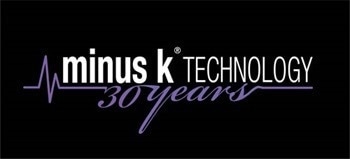
This information has been sourced, reviewed, and adapted from materials provided by Minus K Technology.
For more information on this source, please visit Minus K Technology.